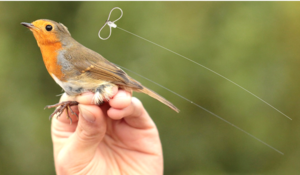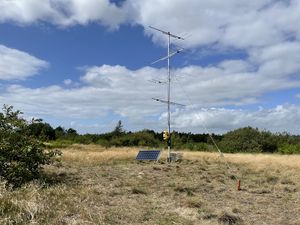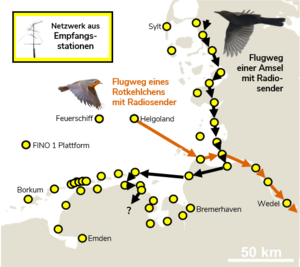Kontakt
Sekretariat

Motus Radiotelemetrie
Eine Methode zur Verfolgung der Bewegungen von Vögeln

Warum Radiotelemetrie?
Während man große Vögel, wie Störche, Greifvögel oder Enten, mit satelliten- oder mobilfunkgestützten GPS-Sendern verfolgen kann, sind Singvögel dafür zu klein und zu leicht, um solche Geräte ohne Beeinträchtigungen tragen zu können. Radiosender sind hingegen mittlerweile so klein geworden, dass sehr leichte Tiere, wie Fledermäuse, Singvögel oder sogar Insekten, mit diesen ausgestattet und dann verfolgt werden können.

Wie funktioniert Radiotelemetrie?
Die Sender emittieren ein individuelles Radiosignal, welches einem kurzen ‚Klicken‘ alle paar Sekunden ähnelt. Dieses Signal wird mit einem Radioempfänger aufgenommen. Um die Reichweite zu erhöhen, kommen dabei gerichtete Yagi-Antennen, wie man sie teilweise auf Hausdächern für den TV-Empfang vorfindet, zum Einsatz. Während man bis vor wenigen Jahren die Tiere noch mit Handempfängern zu Fuß verfolgt hat, haben sich mittlerweile fest installierte, voll automatisierte Empfangsstationen zur Erfassung etabliert.

Netzwerk-Effekt
Die einzelnen Antennen einer Empfangsstation haben eine Reichweite von bis zu 20 km. Außerhalb dieser Reichweite bleibt der Flugweg des Vogels unbekannt. Um längere Bereiche der Flugwege aufzuzeichnen, werden mehrere Empfangsstationen entlang vermuteter Wanderrouten aufgestellt. Durch internationale Kooperation und Standardisierung entsteht derzeit ein weltweites Netzwerk. So profitiert von jeder aufgestellten Station nicht nur ein Wissenschaftsteam, sondern die gesamte Gemeinschaft an Vogelforschenden. Mehr Infos, öffentliche Daten und aktuelle Karten verfügbar auf: www.motus.org/dashboard
Auch Sie können durch die Bereitstellung eines strategischen Standortes zu diesem Netzwerk beitragen und die Vogelzugforschung unterstützen! Weitere, auch technische, Informationen dazu erhalten Sie hier:
Infoblatt Radiotelemetrie
Publikationen der Arbeitsgruppe Migrationsökologie unter Nutzung des Motus Radiotelemetrie-Netzwerks
Die Methode der Radiotelemetrie mit Motus kann für vielfältige Fragestellungen genutzt werden: von Grundlagenstudien zur Physiologie und Ökologie der Vögel, über ihre Orientierung am Magnetfeld bis hin zum Artenschutz mit Hinblick auf Konfliktpotential mit Offshore Windkraftanlagen. Die Publikationen aus der Arbeitsgruppe bilden dieses breite Spektrum gut ab.
Publikationen
Klinner, T.*, Karwinkel, T.*, Packmor, F., & Schmaljohann, H. (2025). Stopover departure decisions in spring: pre-Saharan migrants stay longer and are more selective for favourable wind than trans-Saharan migrants. Movement Ecology, 13(1), 64. https://doi.org/10.1186/s40462-025-00575-0
*shared first authorship
Mitchell, L., Brust, V., Karwinkel, T., Åkesson, S., Kishkinev, D., Norevik, G., Szep, T., Hedenström, A., Lagerveld, S., Helm, B., & Schmaljohann, H. (2025). Conservation-focused mapping of avian migratory routes using a pan-European automated telemetry network. Conservation Biology, e70017. https://doi.org/10.1111/cobi.70017
Lagerveld, S., de Vries, P., Harris, J., Parsons, S., Debusschere, E., Hüppop, O., ... & Schmaljohann, H. (2024). Migratory movements of bats are shaped by barrier effects, sex-biased timing and the adaptive use of winds. Movement Ecology, 12(1), 81. https://doi.org/10.1186/s40462-024-00520-7
Karwinkel, T., Winklhofer, M., Allenstein, D., Brust, V., Christoph, P., Holland, R. A., ... & Schmaljohann, H. (2024). A refined magnetic pulse treatment method for magnetic navigation experiments with adequate sham control: a case study on free-flying songbirds. Journal of the Royal Society Interface, 21(214), 20230745.
Rüppel, G., Hüppop, O., Schmaljohann, H., & Brust, V. (2023). The urge to breed early: Similar responses to environmental conditions in short‐and long‐distance migrants during spring migration. Ecology and Evolution, 13(7), e10223.
Rüppel, G., Hüppop, O., Lagerveld, S., Schmaljohann, H., & Brust, V. (2023). Departure, routing and landing decisions of long-distance migratory songbirds in relation to weather. Royal Society Open Science, 10(2), 221420.
Eikenaar, C., Ostolani, A., Brust, V., Karwinkel, T., Schmaljohann, H., & Isaksson, C. (2023). The oxidative balance and stopover departure decisions in a medium-and a long-distance migrant. Movement Ecology, 11(1), 7.
Brust, V., Schmaljohann, H., & Hüppop, O. (2023). Two subspecies of a songbird migrant optimise departure from a coastal stopover with regard to weather and the route lying ahead. Journal of Avian Biology, 2023(1-2), e03004.
Brust, V., Eikenaar, C., Packmor, F., Schmaljohann, H., Hüppop, O., & Czirják, G. Á. (2022). Do departure and flight route decisions correlate with immune parameters in migratory songbirds?. Functional ecology, 36(12), 3007-3021.
Bach, P., Voigt, C. C., Göttsche, M., Bach, L., Brust, V., Hill, R., ... & Seebens‐Hoyer, A. (2022). Offshore and coastline migration of radio‐tagged Nathusius' pipistrelles. Conservation Science and Practice, 4(10), e12783.
Karwinkel, T., Winklhofer, M., Janner, L. E., Brust, V., Hüppop, O., Bairlein, F., & Schmaljohann, H. (2022). A magnetic pulse does not affect free-flight navigation behaviour of a medium-distance songbird migrant in spring. Journal of Experimental Biology, 225(19), jeb244473.
Karwinkel, T., Winklhofer, M., Christoph, P., Allenstein, D., Hüppop, O., Brust, V., ... & Schmaljohann, H. (2022). No apparent effect of a magnetic pulse on free-flight behaviour in northern wheatears (Oenanthe oenanthe) at a stopover site. Journal of the Royal Society Interface, 19(187), 20210805.
Brust V, Hüppop O (2021) Underestimated scale of songbird offshore migration across the south-eastern North Sea during autumn. Journal of Ornithology, 1-10.
Michalik B, Brust V, Hüppop O (2020) Are movements of daytime and nighttime passerine migrants as different as day and night? Ecology and Evolution 00: 1-12,
Schmaljohann, H., & Klinner, T. (2020). A quasi-experimental approach using telemetry to assess migration-strategy-specific differences in the decision-making processes at stopover. BMC ecology, 20, 1-12.
Packmor, F., Klinner, T., Woodworth, B. K., Eikenaar, C., & Schmaljohann, H. (2020). Stopover departure decisions in songbirds: do long-distance migrants depart earlier and more independently of weather conditions than medium-distance migrants?. Movement Ecology, 8, 1-14.
Eikenaar, C., Schaefer, J., Hessler, S., Packmor, F., & Schmaljohann, H. (2020). Diel variation in corticosterone and departure decision making in migrating birds. Hormones and behavior, 122, 104746.
Brust V, Michalik B, Hüppop O (2019) To cross or not to cross – thrushes at the German North Sea coast adapt flight and routing to wind conditions in autumn, Movement Ecology 7:32,
Eikenaar, C., Packmor, F., Schmaljohann, H., & Hegemann, A. (2019). Stopover departure decisions in autumn are not associated with constitutive immune function in Northern Wheatears Oenanthe oenanthe. Journal of ornithology, 160, 813-817.
Eikenaar, C., Hessler, S., Ballstaedt, E., Schmaljohann, H., & Kaiya, H. (2018). Ghrelin, corticosterone and the resumption of migration from stopover, an automated telemetry study. Physiology & behavior, 194, 450-455.
Schmaljohann, H., Mueller, F., Klinner, T., & Eikenaar, C. (2018). Potential age differences in the migratory behaviour of a nocturnal songbird migrant during autumn and spring. Journal of Avian Biology, 49(7), e01815.
Müller, F., Eikenaar, C., Crysler, Z. J., Taylor, P. D., & Schmaljohann, H. (2018). Nocturnal departure timing in songbirds facing distinct migratory challenges. Journal of Animal Ecology, 87(4), 1102-1115.
Eikenaar, C., Müller, F., Leutgeb, C., Hessler, S., Lebus, K., Taylor, P. D., & Schmaljohann, H. (2017). Corticosterone and timing of migratory departure in a songbird. Proceedings of the Royal Society B: Biological Sciences, 284(1846), 20162300.

